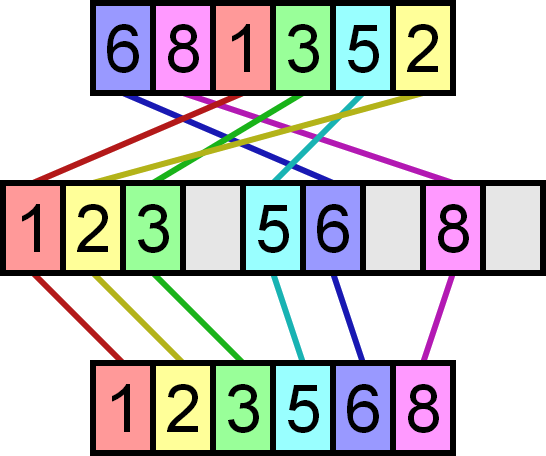Counting Sort
Description
Counting Sort is a non-comparison based sorting algorithm that works by counting the number of occurrences of each element in the array. It operates by creating an auxiliary array to store the frequencies of each element, and then using this information to place elements in their correct sorted positions.
History

Counting Sort emerged in the early days of computer science, during the 1950s, when researchers were exploring non-comparison based sorting methods. Unlike many other sorting algorithms that are named after their inventors, Counting Sort is named after its process of counting elements. The algorithm gained prominence as a subroutine in Radix Sort, where it's used to sort numbers digit by digit. Its ability to sort in linear time made it particularly valuable in specific applications where the range of input values is known and reasonably small compared to the number of items to be sorted. The algorithm has found widespread use in various applications, from sorting postal codes to computer graphics rendering pipelines where elements need to be sorted by depth (z-index).
How It Works
- Count Frequencies:
- Create a count array of size k (range of input)
- Count occurrences of each element
- Calculate Cumulative Count:
- Modify count array to store actual positions
- Each element shows final position of elements
- Build Output Array:
- Place each element in its correct position
- Decrement count for each placement
Visualization
Click Start to begin visualization
Implementation
def counting_sort(arr):
# Find the range of input array
max_val = max(arr)
min_val = min(arr)
range_val = max_val - min_val + 1
# Initialize count array and output array
count = [0] * range_val
output = [0] * len(arr)
# Store count of each element
for i in arr:
count[i - min_val] += 1
# Modify count array to store actual positions
for i in range(1, len(count)):
count[i] += count[i - 1]
# Build output array
for i in range(len(arr) - 1, -1, -1):
output[count[arr[i] - min_val] - 1] = arr[i]
count[arr[i] - min_val] -= 1
# Copy output array to input array
for i in range(len(arr)):
arr[i] = output[i]
return arr
void countingSort(vector& arr) {
// Find range of array elements
int max_val = *max_element(arr.begin(), arr.end());
int min_val = *min_element(arr.begin(), arr.end());
int range = max_val - min_val + 1;
// Create count array and output array
vector count(range), output(arr.size());
// Store count of each element
for(int i = 0; i < arr.size(); i++)
count[arr[i] - min_val]++;
// Modify count array to store actual positions
for(int i = 1; i < count.size(); i++)
count[i] += count[i-1];
// Build output array
for(int i = arr.size()-1; i >= 0; i--) {
output[count[arr[i] - min_val] - 1] = arr[i];
count[arr[i] - min_val]--;
}
// Copy output array to input array
for(int i = 0; i < arr.size(); i++)
arr[i] = output[i];
}
// Example usage
int main() {
vector arr = {64, 34, 25, 12, 22, 11, 90};
cout << "Original array: ";
for(int num : arr) cout << num << " ";
countingSort(arr);
cout << "\nSorted array: ";
for(int num : arr) cout << num << " ";
return 0;
}
public class CountingSort
{
public static void Sort(int[] arr)
{
// Find range of array elements
int maxVal = arr.Max();
int minVal = arr.Min();
int range = maxVal - minVal + 1;
// Create count array and output array
int[] count = new int[range];
int[] output = new int[arr.Length];
// Store count of each element
for(int i = 0; i < arr.Length; i++)
count[arr[i] - minVal]++;
// Modify count array to store actual positions
for(int i = 1; i < count.Length; i++)
count[i] += count[i - 1];
// Build output array
for(int i = arr.Length - 1; i >= 0; i--)
{
output[count[arr[i] - minVal] - 1] = arr[i];
count[arr[i] - minVal]--;
}
// Copy output array to input array
for(int i = 0; i < arr.Length; i++)
arr[i] = output[i];
}
// Example usage
public static void Main(string[] args)
{
int[] arr = { 64, 34, 25, 12, 22, 11, 90 };
Console.WriteLine("Original array: " + string.Join(" ", arr));
Sort(arr);
Console.WriteLine("Sorted array: " + string.Join(" ", arr));
}
}
Applications
- Sorting integers with known range
- Sorting postal codes
- Sorting strings (as part of radix sort)
- Computer graphics (sorting by z-index)
- DNA sequence analysis
Advantages and Disadvantages
Advantages
- Linear time complexity O(n + k)
- Stable sorting algorithm
- Efficient for integers with known range
- Good as a subroutine in radix sort
Disadvantages
- Not in-place sorting
- Requires extra space O(k)
- Only works with discrete values
- Not efficient when range k is much larger than n
Complexity Analysis
| Case | Time Complexity | Description |
|---|---|---|
| Best Case | Ω(n + k) | Always performs same operations regardless of input arrangement |
| Average Case | Θ(n + k) | Requires two passes through array of size n and one through count array of size k |
| Worst Case | O(n + k) | Same as other cases due to non-comparative nature |
| Space Complexity | O(k) | Requires count array of size k and output array of size n |
Notes:
- n - Number of elements in the input array
- k - Range of input (max - min + 1)
- Linear time complexity when k = O(n)
- Not efficient when k >> n (range much larger than array size)
- Performance independent of input distribution